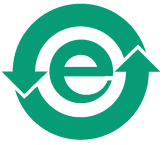Restriction of Hazardous Substances in China

Treehugger, a blog I like, has an update on a new law in China to control pollution from electronic products.
The Chinese law will come into effect on 1 March, 2007. It will target the same six hazardous substances which are regulated by EU and Japan, namely the heavy metals cadmium, lead, mercury, and hexavalent chromium as well as two flame retardants, PBB and PBDE:
The main means of control will be a mark which must be affixed by suppliers to the device sold, or clearly printed in papers accompanying the supplied goods if marking is not possible. The green e with two arrows chasing each other in a circle is the mark of equipment which is free of the targeted substances. The orange symbol exemplifies the marking of the product's "environmentally friendly use period".
Japanese manufacturers have begun phasing out lead and other harmful materials, and Japan does have a marking requirement called J-MOSS, wich came into effect on 1 July, 2006, on many electronic products. According to RSJ Technical Consulting, Japan has chosen a more comprehensive approach than European RoHS rules. In Japan, manufacturers and importers of computers, televisions, refrigerators, washers & dryers, microwaves and air conditioners must label their products to indicate presence of the six RoHS substances: lead, mercury, chromium VI, cadmium, PBB & PBDE. This judgment criteria is known as JIS C 0950. Also, importers of computers, copiers, televisions, refrigerators, washers & dryers, microwaves and air conditioners must now meet the Design for Environment (DfE) criteria required of domestic manufacturers.
South Korea appear to be planning a similar legislation by 1 March, 2007.
Comments